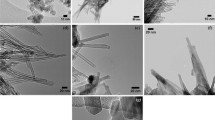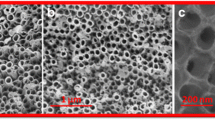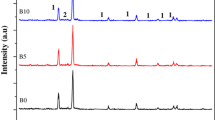Abstract
Titanate nanotubes offer certain benefits like high specific surface area, anisotropic mesoporous structure and ease of synthesis over other nanostructured titania forms. However, their application in visible light driven photocatalysis is hindered by their wide band-gap, which can be remedied by, e.g., anionic doping. Here we report on a systematic study to insert nitrogen into lattice positions in titanate nanotubes. The efficiency of N2+ bombardment, N2 plasma and NH3 plasma treatment is compared to that of NH3 gas synthesized in situ by the thermal decomposition of urea or NH4F. N2+ bombarded single crystalline rutile TiO2 was used as a doping benchmark (16 at.% N incorporated). Surface species were identified by diffuse reflectance infrared spectroscopy, structural features were characterized by scanning electron microscopy and powder X-ray diffraction measurements. The local chemical environment of nitrogen built into the nanotube samples was probed by X-ray photoelectron spectroscopy. Positively charged NH3 plasma treatment offered the best doping performance. This process succeeded in inserting 20 at.% N into nanotube lattice positions by replacing oxygen and forming Ti–N bonds. Remarkably, the nanotubular morphology and titanate crystal structure were both fully conserved during the process. Since plasma treatment is a readily scalable technology, the suggested method could be utilized in developing efficient visible light driven photocatalysts based on N-doped titanate nanotubes.









Similar content being viewed by others
References
Bavykin DV, Parmon VN, Lapkin AA, Walsh FC (2004) The effect of hydrothermal conditions on the mesoporous structure of TiO2 nanotubes. J Mater Chem 14(22):3370–3377. https://doi.org/10.1039/b406378c
Kasuga T, Hiramatsu M, Hoson A, Sekino T, Niihara K (1998) Formation of titanium oxide nanotube. Langmuir 14(12):3160–3163. https://doi.org/10.1021/la9713816
Pótári G, Madarász D, Nagy L, László B, Sápi A, Oszkó A, Kukovecz A, Erdohelyi A, Kónya Z, Kiss J (2013) Rh-induced support transformation phenomena in titanate nanowire and nanotube catalysts. Langmuir 29(9):3061–3072. https://doi.org/10.1021/la304470v
Kukovecz Á, Kordás K, Kiss J, Kónya Z (2016) Atomic scale characterization and surface chemistry of metal modified titanate nanotubes and nanowires. Surf Sci Rep 71(3):473–546. https://doi.org/10.1016/j.surfrep.2016.06.001
Buchholcz B, Haspel H, Boldizsár T, Kukovecz Á, Kónya Z (2017) pH-regulated antimony oxychloride nanoparticle formation on titanium oxide nanostructures: a photocatalytically active heterojunction. CrystEngComm 19(10):1408–1416. https://doi.org/10.1039/c6ce02340a
Buchholcz B, Haspel H, Oszkó A, Kukovecz A, Kónya Z (2017) Titania nanotube stabilized BiOCl nanoparticles in visible-light photocatalysis. RSC Adv 7(27):16410–16422. https://doi.org/10.1039/c6ra28490f
Sluban M, Cojocaru B, Parvulescu VI, Iskra J, Korošec RC, Umek P (2017) Protonated titanate nanotubes as solid acid catalyst for aldol condensation. J Catal 346:161–169. https://doi.org/10.1016/j.jcat.2016.12.015
Kuwahara Y, Fujie Y, Yamashita H (2017) Poly-(ethyleneimine)-tethered Ir complex catalyst immobilized in titanate nanotubes for hydrogenation of CO2 to formic acid. ChemCatChem 9(11):1906–1914. https://doi.org/10.1002/cctc.201700508
Aouadi I, Touati H, Tatibouët J-M, Bergaoui L (2017) Titanate nanotubes as ethanol decomposition catalysts: effect of coupling photocatalysis with non-thermal plasma. J Photochem Photobiol A 346:485–492. https://doi.org/10.1016/j.jphotochem.2017.06.030
Sandoval A, Hernández-Ventura C, Klimova TE (2017) Titanate nanotubes for removal of methylene blue dye by combined adsorption and photocatalysis. Fuel 198:22–30. https://doi.org/10.1016/j.fuel.2016.11.007
László B, Baán K, Varga E, Oszkó A, Erdőhelyi A, Kónya Z, Kiss J (2016) Photo-induced reactions in the CO2-methane system on titanate nanotubes modified with Au and Rh nanoparticles. Appl Catal B 199:473–484. https://doi.org/10.1016/j.apcatb.2016.06.057
Bavykin DV, Walsh FC (2007) Kinetics of alkali metal ion exchange into nanotubular and nanofibrous titanates. J Phys Chem C 111(40):14644–14651. https://doi.org/10.1021/jp073799a
Bavykin DV, Lapkin AA, Plucinski PK, Friedrich JM, Walsh FC (2005) Reversible storage of molecular hydrogen by sorption into multilayered TiO2 nanotubes. J Phys Chem B 109(41):19422–19427. https://doi.org/10.1021/jp0536394
Paris J, Bernhard Y, Boudon J, Heintz O, Millot N, Decréau R (2015) Phthalocyanine–titanate nanotubes: a promising nanocarrier detectable by optical imaging in the so-called imaging window. RSC Adv 5(9):6315–6322. https://doi.org/10.1039/c4ra13988g
Yang D, Wang X, Ai Q, Shi J, Jiang Z (2015) Performance comparison of immobilized enzyme on the titanate nanotube surfaces modified by poly-(dopamine) and poly-(norepinephrine). RSC Adv 5(53):42461–42467. https://doi.org/10.1039/c5ra02420j
Chen Q, Du G, Zhang S, Peng L-M (2002) The structure of trititanate nanotubes. Acta Crystallogr Sect B 58(4):587–593. https://doi.org/10.1107/S0108768102009084
Dmitry V, Walsh C (2010) Titanate and titania nanotubes: synthesis, properties and applications. Royal Society of Chemisty, Cambridge, https://doi.org/10.1039/9781849730778
Kukovecz Á, Hodos M, Horváth E, Radnóczi G, Kónya Z, Kiricsi I (2005) Oriented crystal growth model explains the formation of titania nanotubes. J Phys Chem B 109(38):17781–17783. https://doi.org/10.1021/jp054320m
Diebold U (2003) The surface science of titanium-dioxide. Surf Sci Rep 48(5):53–229. https://doi.org/10.1016/S0167-5729(02)00100-0
Wang L, Sasaki T (2014) Titanium-oxide nanosheets: graphene analogues with versatile functionalities. Chem Rev 114(19):9455–9486. https://doi.org/10.1021/cr400627u
Houas A, Lachheb H, Ksibi M, Elaloui E, Guillard C, Herrmann J-M (2001) Photocatalytic degradation pathway of methylene blue in water. Appl Catal B 31(2):145–157. https://doi.org/10.1016/S0926-3373(00)00276-9
Thiruvenkatachari R, Vigneswaran S, Moon IS (2008) A review on UV/TiO2 photocatalytic oxidation process (Journal Review). Korean J Chem Eng 25(1):64–72. https://doi.org/10.1007/s11814-008-0011-8
Halasi G, Schubert GB, Solymosi F (2012) Photodecomposition of formic acid on N-doped and metal-promoted TiO2 production of CO-free H2. J Phys Chem C 116(29):15396–15405. https://doi.org/10.1021/jp3030478
Kumar SG, Devi LG (2011) Review on modified TiO2 photocatalysis under UV/visible light: selected results and related mechanisms on interfacial charge carrier transfer dynamics. J Phys Chem A 115(46):13211–13241. https://doi.org/10.1021/jp204364a
Rehman S, Ullah R, Butt A, Gohar N (2009) Strategies of making TiO2 and ZnO visible light active. J Hazard Mater 170(2):560–569. https://doi.org/10.1016/j.jhazmat.2009.05.064
Qin W, Zhang D, Zhao D, Wang L, Zheng K (2010) Near-infrared photocatalysis based on YF3: Yb3+, Tm3+/TiO2 core/shell nanoparticles. Chem Commun 46(13):2304–2306. https://doi.org/10.1039/b924052g
Tang Y, Di W, Zhai X, Yang R, Qin W (2013) NIR-responsive photocatalytic activity and mechanism of NaYF4: Yb, Tm@ TiO2 core–shell nanoparticles. ACS Catal 3(3):405–412. https://doi.org/10.1021/cs300808r
Henderson MA (2011) A surface science perspective on photocatalysis. Surf Sci Rep 66(6):185–297. https://doi.org/10.1016/j.surfrep.2011.01.001
Park MS, Kwon S, Min B (2002) Electronic structures of doped anatase TiO2: Ti1–xMxO2 (M = Co, Mn, Fe, Ni). Phys Rev B 65(16):161201. https://doi.org/10.1103/PhysRevB.65.161201
Kočí K, Matějů K, Obalová L, Krejčíková S, Lacný Z, Plachá D, Čapek L, Hospodková A, Šolcová O (2010) Effect of silver doping on the TiO2 for photocatalytic reduction of CO2. Appl Catal B 96(3):239–244. https://doi.org/10.1016/j.apcatb.2010.02.030
Dozzi MV, Selli E (2013) Doping TiO2 with p-block elements: effects on photocatalytic activity. J Photochem Photobiol C 14:13–28. https://doi.org/10.1016/j.jphotochemrev.2012.09.002
Devi LG, Kavitha R (2013) A review on non metal ion doped titania for the photocatalytic degradation of organic pollutants under UV/solar light: role of photogenerated charge carrier dynamics in enhancing the activity. Appl Catal B 140:559–587. https://doi.org/10.1016/j.apcatb.2013.04.035
Serpone N (2006) Is the band gap of pristine TiO2 narrowed by anion- and cation-doping of titanium dioxide in second-generation photocatalysts? J Phys Chem B 110(48):24287–24293. https://doi.org/10.1021/jp065659r
Gracia F, Holgado JP, Caballero A, Gonzalez-Elipe AR (2004) Structural, optical, and photoelectrochemical properties of Mn+–TiO2 model thin film photocatalysts. J Phys Chem B 108(45):17466–17476. https://doi.org/10.1021/jp0484938
Asahi R, Morikawa T, Ohwaki T, Aoki K, Taga Y (2001) Visible-light photocatalysis in nitrogen-doped titanium oxides. Science 293(5528):269–271. https://doi.org/10.1126/science.1061051
Sato S (1986) Photocatalytic activity of NOx-doped TiO2 in the visible light region. Chem Phys Lett 123(1–2):126–128. https://doi.org/10.1016/0009-2614(86)87026-9
Jagadale TC, Takale SP, Sonawane RS, Joshi HM, Patil SI, Kale BB, Ogale SB (2008) N-doped TiO2 nanoparticle based visible light photocatalyst by modified peroxide sol–gel method. J Phys Chem C 112(37):14595–14602. https://doi.org/10.1021/jp803567f
Hanaor DA, Sorrell CC (2011) Review of the anatase to rutile phase transformation. J Mater Sci 46(4):855–874. https://doi.org/10.1007/s10853-010-5113-0
Buchholcz B, Varga E, Varga T, Plank K, Kiss J, Kónya Z (2017) Structure and stability of boron doped titanate nanotubes and nanowires. Vacuum 138:120–124. https://doi.org/10.1016/j.vacuum.2016.11.038
Pusztai P, Puskás R, Varga E, Erdőhelyi A, Kukovecz Á, Kónya Z, Kiss J (2014) Influence of gold additives on the stability and phase transformation of titanate nanostructures. Phys Chem Chem Phys 16(48):26786–26797. https://doi.org/10.1039/c4cp04084h
Halasi G, Schubert G, Solymosi F (2012) Comparative study on the photocatalytic decomposition of methanol on TiO2 modified by N and promoted by metals. J Catal 294:199–206. https://doi.org/10.1016/j.jcat.2012.07.020
Joung S-K, Amemiya T, Murabayashi M, Itoh K (2006) Relation between photocatalytic activity and preparation conditions for nitrogen-doped visible light-driven TiO2 photocatalysts. Appl Catal A 312:20–26. https://doi.org/10.1016/j.apcata.2006.06.027
Wang Z, Cai W, Hong X, Zhao X, Xu F, Cai C (2005) Photocatalytic degradation of phenol in aqueous nitrogen-doped TiO2 suspensions with various light sources. Appl Catal B 57(3):223–231. https://doi.org/10.1016/j.apcatb.2004.11.008
Di Valentin C, Finazzi E, Pacchioni G, Selloni A, Livraghi S, Paganini MC, Giamello E (2007) N-doped TiO2: theory and experiment. Chem Phys 339(1):44–56. https://doi.org/10.1016/j.chemphys.2007.07.020
Buchholcz B, Haspel H, Kukovecz Á, Kónya Z (2014) Low-temperature conversion of titanate nanotubes into nitrogen-doped TiO2 nanoparticles. CrystEngComm 16(32):7486–7492. https://doi.org/10.1039/c4ce00801d
Chang J-C, Tsai W-J, Chiu T-C, Liu C-W, Chao J-H, Lin C-H (2011) Chemistry in a confined space: characterization of nitrogen-doped titanium oxide nanotubes produced by calcining ammonium trititanate nanotubes. J Mater Chem 21(12):4605–4614. https://doi.org/10.1039/c0jm03058a
Maeda M, Watanabe T (2006) Visible light photocatalysis of nitrogen-doped titanium oxide films prepared by plasma-enhanced chemical vapor deposition. J Electrochem Soc 153(3):C186-C189. https://doi.org/10.1149/1.2165773
Bertóti I (2012) Nitrogen modified metal oxide surfaces. Catal Today 181(1):95–101. https://doi.org/10.1016/j.cattod.2011.06.017
Sullivan JL, Saied SO, Bertoti I (1991) Effect of ion and neutral sputtering on single crystal TiO2. Vacuum 42(18):1203–1208. https://doi.org/10.1016/0042-207X(91)90131-2
Bertóti I, Kelly R, Mohai M, Tóth A (1992) A possible solution to the problem of compositional change with ion-bombarded oxides. Surf Interface Anal 19(1–12):291–297. https://doi.org/10.1002/sia.740190155
Bertóti I, Kelly R, Mohai M, Tóth A (1993) Response of oxides to ion bombardment: the difference between inert and reactive ions. Nuclear Instrum Methods Phys Res Sect B 80–81 (Part 2):1219–1225. https://doi.org/10.1016/0168-583X(93)90770-7
Mohai M (2004) XPS MultiQuant: multimodel XPS quantification software. Surf Interface Anal 36(8):828–832. https://doi.org/10.1002/sia.1775
Mohai M, Bertoti I (2004) Calculation of overlayer thickness on curved surfaces based on XPS intensities. Surf Interface Anal 36(8):805–808. https://doi.org/10.1002/sia.1769
Reilman RF, Msezane A, Manson ST (1976) Relative intensities in photoelectron spectroscopy of atoms and molecules. J Electron Spectrosc Relat Phenom 8(5):389–394. https://doi.org/10.1016/0368-2048(76)80025-4
Bavykin DV, Friedrich JM, Lapkin AA, Walsh FC (2006) Stability of aqueous suspensions of titanate nanotubes. Chem Mater 18(5):1124–1129. https://doi.org/10.1021/cm0521875
Diwald O, Thompson TL, Zubkov T, Walck SD, Yates JT (2004) Photochemical activity of nitrogen-doped rutile TiO2(110) in visible light. J Phys Chem B 108(19):6004–6008. https://doi.org/10.1021/jp031267y
Thompson TL, Yates JT (2006) Surface science studies of the photoactivation of TiO2—new photochemical processes. Chem Rev 106(10):4428–4453. https://doi.org/10.1021/cr050172k
Beranek R, Kisch H (2008) Tuning the optical and photoelectrochemical properties of surface-modified TiO2. Photochem Photobiol Sci 7(1):40–48. https://doi.org/10.1039/B711658F
Souto S, Alvarez F (1997) The role of hydrogen in nitrogen-containing diamondlike films studied by photoelectron spectroscopy. Appl Phys Lett 70(12):1539–1541. https://doi.org/10.1063/1.118611
Batzill M, Morales EH, Diebold U (2006) Influence of nitrogen doping on the defect formation and surface properties of TiO2 rutile and anatase. Phys Rev Lett 96(2):026103. https://doi.org/10.1103/PhysRevLett.96.026103
Jung SM, Grange P (2000) The investigation of mechanism of SCR reaction on a TiO2-SO4 2– catalyst by DRIFTS. Appl Catal B 27(1):L11-L16. https://doi.org/10.1016/S0926-3373(00)00145-4
Ramis G, Busca G, Lorenzelli V, Forzatti P (1990) Fourier transform infrared study of the adsorption and coadsorption of nitric oxide, nitrogen dioxide and ammonia on TiO2 anatase. Appl Catal 64:243–257. https://doi.org/10.1016/S0166-9834(00)81564-X
Acknowledgements
The financial support of the Hungarian Research Development and Innovation Office through Grants NKFIH OTKA K 126065 (Á.K.), K 120115 (Z.K.) and GINOP-2.3.2-15-2016-0013 (Á.K., Z.K.) is acknowledged.
Author information
Authors and Affiliations
Corresponding authors
Rights and permissions
About this article
Cite this article
Buchholcz, B., Plank, K., Mohai, M. et al. Morphology Conserving High Efficiency Nitrogen Doping of Titanate Nanotubes by NH3 Plasma. Top Catal 61, 1263–1273 (2018). https://doi.org/10.1007/s11244-018-0981-7
Published:
Issue Date:
DOI: https://doi.org/10.1007/s11244-018-0981-7




